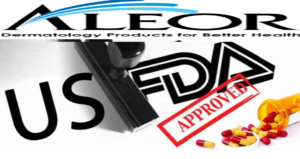SYNOPSIS:
- Alembic Pharmaceuticals Limited announced that its joint venture Aleor Dermaceuticals Limited has received final approval from the US Food & Drug Administration (FDA) for its Abbreviated New Drug Application (ANDA) for mupirocin cream USP, 2%
- Mupirocin is on the World Health Organization’s List of Essential Medicines.
- Alembic has received year-to-date (YTD) 13 approvals (10 final approvals and 3 tentative approvals) and a cumulative total of 152 ANDA approvals (133 final approvals and 19 tentative approvals) from USFDA.
- Mupirocin Cream USP, 2% is indicated for the treatment of secondarily infected traumatic skin lesions (up to 10 cm in length or 100 cm2 in area) due to susceptible strains of S. aureus and S. pyogenes.
- Aleor has been granted a Competitive Generic Therapies (CGT) designation for this ANDA and it is eligible for 180 days of CGT exclusivity as it is the first approved applicant.

Alembic Pharma JV Aleor Derma Receives USFDA Approval for Mupirocin Cream a Therapeutically Generic Version of Bactroban Cream, 2%
Alembic Pharmaceuticals announced that its joint venture Aleor Dermaceuticals (Aleor) has received final approval from the US Food & Drug Administration (USFDA) for its Abbreviated New Drug Application (ANDA) for Mupirocin Cream USP, 2%. The approved ANDA is therapeutically equivalent to the reference listed drug product (RLD), Bactroban Cream, 2%, of SmithKline Beecham(Cork), Ireland (SmithKline).
Mupirocin Cream USP, 2% is indicated for the treatment of secondarily infected traumatic skin lesions (up to 10 cm in length or 100 cm2 in area) due to susceptible strains of S. aureus and S. pyogenes.
Aleor has been granted a Competitive Generic Therapies (CGT) designation for this ANDA and it is eligible for 180 days of CGT exclusivity as it is the first approved applicant.
Mupirocin Cream USP, 2% has an estimated market size of US$ 28 million for twelve months ending Jun 2021 according to IQVIA. Alembic has received year to date (YTD) 13 approvals (10 final approvals and 3 tentative approvals) and a cumulative total of 152 ANDA approvals (133 final approvals and 19 tentative approvals) from USFDA.
What is Mupirocin?
Mupirocin is an alpha,beta-unsaturated ester resulting from the formal condensation of the alcoholic hydroxy group of 9-hydroxynonanoic acid with the carboxy group of (2E)-4-[(2S)-tetrahydro-2H-pyran-2-yl]-3-methylbut-2-enoic acid in which the tetrahydropyranyl ring is substituted at positions 3 and 4 by hydroxy groups and at position 5 by a {(2S,3S)-3-[(2S,3S)-3-hydroxybutan-2-yl]oxiran-2-yl}methyl group. Originally isolated from the Gram-negative bacterium Pseudomonas fluorescens, it is used as a topical antibiotic for the treatment of Gram-positive bacterial infections. It has a role as a bacterial metabolite, an antibacterial drug and a protein synthesis inhibitor. It is a monocarboxylic acid, a member of oxanes, an epoxide, a secondary alcohol, a triol and an alpha,beta-unsaturated carboxylic ester. It is a conjugate acid of a mupirocin

Pseudomonic acid A (PA-A), the principal component of mupirocin
Mupirocin, formerly termed pseudomonic acid A, is a novel antibacterial agent with a unique chemical structure and mode of action apart from other antibiotic agents. Produced by fermentation using the organism Pseudomonas fluorescens, mupirocin is a naturally-occurring antibiotic that displays a broad-specturm activity against many gram-positive bacteria and certain gram-negative bacteria in vitro. It primarily works by inhibiting bacterial protein synthesis. Due to its unique mode of action of inhibiting the activity of bacterial isoleucyl-tRNA synthetase, mupirocin does not demonstrate cross-resistance with other classes of antimicrobial agents, giving it a therapeutic advantage. It is available in topical formulations only due to extensive systemic metabolism and is used in the treatment of impetigo caused by Staphylococcus aureus and Streptococcus pyogenes and traumatic skin lesions due to secondary skin infections caused by S. aureus and S. pyogenes. There is also some clinical evidence that suggests the potential role of mupirocin in eradicating nasal carriage of Staphylococci when administered intranasally. Mupirocin is commonly marketed under the brand name Bactroban.
Pharmacology:
Mupirocin is reported to be active against susceptible aerobic gram-positive cocci, such as _Staphylococcus aureus_, _Staphylococcus epidermidis_, and other beta-hemolytic streptococci_Streptococcus pyogenes_. It mediates its antibacterial activity by inhibiting the bacterial protein synthesis and formation of bacterial proteins essential for survival. The minimum bactericidal concentration (MBC) against relevant pathogens is generally eight-fold to thirty-fold higher than the minimum inhibitory concentration (MIC). In one clinical study investigating the therapeutic effectiveness of topical mupirocin in impetigo, the therapeutic response rate was about 94 to 98% after one week following the end of therapy. In clinical studies of patients with primary and secondary skin infections, both elimination of the bacterial pathogen and clinical cure or improvement hav been demonstrated in over 90% of patients receiving topical mupirocin. Mupirocin resistance as high as 81% has been reported previously. Resistance to mupirocin, which occurs more frequently in methicillin-resistant than methicillin-susceptible staphylococci, may occur with the production of a modified isoleucyl-tRNA synthetase, or the acquisition of, by genetic transfer, a plasmid mediating a new isoleucyl-tRNA synthetase.
Absorption:
Systemic or percutaneous absorption of mupirocin following dermal application is expected to be minimal in adults and children. Occlusive dressings do not significantly enhance drug absorption, but damaged skin may allow enhanced penetration of the drug across the skin barrier.
Route of Elimination:
Any mupirocin reaching the systemic circulation is rapidly metabolized to form the inactive monic acid, which is eliminated by renal excretion. Following the application of Centany (mupirocin ointment),2% to a 400 cm2 area on the back of 23 healthy volunteers once daily for 7 days, the mean (range) cumulative urinary excretion of monic acid over 24 hrs following the last administration was 1.25% (0.2% to 3.0%) of the administered dose of mupirocin.
Mupirocin specifically and reversibly binds to bacterial isoleucyl transfer-RNA (tRNA) synthetase, which is an enzyme that promotes the conversion of isoleucine and tRNA to isoleucyl-tRNA. Inhibition of this enzyme subsequently leads to the inhibition of the bacterial protein and RNA synthesis. Mupirocin is bacteriostatic at lower concentrations but it exerts bactericidal effects with prolonged exposure, killing 90-99% of susceptible bacteria over a 24 hour period.
Special warnings and precautions for use:
Should a possible sensitisation reaction or severe local irritation occur with the use of Mupirocin Ointment, treatment should be discontinued, the product should be washed off and appropriate therapy instituted.
As with other antibacterial products, prolonged use may result in overgrowth of non-susceptible organisms. Pseudomembranous colitis has been reported with the use of antibiotics and may range in severity from mild to life-threatening. Therefore, it is important to consider its diagnosis in patients who develop diarrhoea during or after antibiotic use. Although this is less likely to occur with topically applied mupirocin, if prolonged or significant diarrhoea occurs or the patient experiences abdominal cramps, treatment should be discontinued immediately and the patient investigated further.
Renal Impairment
Polyethylene glycol can be absorbed from open wounds and damaged skin and is excreted by the kidneys. In common with other polyethylene glycol-based ointments, Mupirocin Ointment should not be used in conditions where absorption of large quantities of polyethylene glycol is possible, especially if there is evidence of moderate or severe renal impairment.
Mupirocin Ointment is not suitable for:
– ophthalmic use;
– intranasal use (in neonates or infants);
– use in conjunction with cannulae;
– at the site of central venous cannulation.
Avoid contact with the eyes. If contaminated, the eyes should be thoroughly irrigated with water until the ointment residues have been removed.
Interaction with other medicinal products and other forms of interaction:
No interaction studies have been performed
Fertility, pregnancy and lactation
Pregnancy:
Reproduction studies on mupirocin in animals have revealed no evidence of harm to the foetus (see section 5.3). As there is no clinical experience on its use during pregnancy, Mupirocin Ointment should only be used in pregnancy when the potential benefits outweigh the possible risks of treatment.
Breast-feeding:
It is unknown whether mupirocin is excreted in human milk. If a cracked nipple is to be treated, it should be thoroughly washed prior to breast-feeding.
Fertility
There are no data on the effects of mupirocin on human fertility. Studies in rats showed no effects on fertility (see section 5.3).
Effects on ability to drive and use machines
Mupirocin 2% w/w Ointment has no or negligible influence on the ability to drive and use machines.
Undesirable effects:
Adverse reactions are listed below by system organ class and frequency. Frequencies are defined as: very common (1/10), common (1/100 to <1/10), uncommon (1/1,000 to <1/100), rare (1/10,000 to <1/1,000), very rare (<1/10,000), including isolated reports.
Common and uncommon adverse reactions were determined from pooled safety data from a clinical trial population of 1573 treated patients encompassing 12 clinical studies. Very rare adverse reactions were primarily determined from post-marketing experience data and therefore refer to reporting rate rather than true frequency.
| System organ class | Frequency | Undesirable effects |
| Immune system disorders | Very rare | Systemic allergic reactions including anaphylaxis, generalised rash, urticaria and angioedema have been reported with Mupirocin Ointment. |
| Skin and subcutaneous tissue disorders | Common
Uncommon |
Burning localised to the area of application
Itching, erythema, stinging and dryness localised to the area of application. Cutaneous sensitisation reactions to mupirocin or the ointment base. |
Reporting of suspected adverse reactions
Reporting suspected adverse reactions after authorisations of the medicinal product is important. It allows continued monitoring of the benefit/risk balance of the medicinal product. Healthcare professionals are asked to report any suspected adverse reactions via the Yellow Card Scheme Website:www.mhra.gov.uk/yellowcard or search for MHRA Yellow Card in the Google Play or Apple App Store.
Pharmacodynamic properties:
Mechanism of Resistance
Low-level resistance in staphylococci is thought to result from point mutations within the usual staphylococcal chromosomal gene (ileS) for the target isoleucyl tRNA synthetase enzyme. High-level resistance in staphylococci has been shown to be due to a distinct, plasmid encoded isoleucyl tRNA synthetase enzyme.
Intrinsic resistance in Gram negative organisms such as the Enterobacteriaceae could be due to poor penetration of the outer membrane of the Gram-negative bacterial cell wall. Due to its particular mode of action, and its unique chemical structure, mupirocin does not show any cross-resistance with other clinically available antibiotics.
Microbiological Susceptibility
The prevalence of acquired resistance may vary geographically and with time for selected species, and local information on resistance is desirable, particularly when treating severe infections. As necessary, expert advice should be sought when the local prevalence of resistance is such that the utility of the agent in at least some types of infection is questionable.
Toxicity
LD50 and Nonclinical Toxicity
The oral LD50 value in rats is 5000 mg/kg.MSDS Studies evaluating the carcinogenic potential of mupirocin have not been performed. In various in vivo animal and in vitro bacterial assays, there was no evidence of genotoxicity caused by mupirocin. In reproduction studies using male and female rats, there were no signs of impaired fertility upon subcutaneous administration of mupirocin.
Use in special populations
Mupirocin was found to be excreted in human milk. As there is limited data on the use of topical mupirocin in pregnant women, the use of this drug in these patients should be undertaken with caution. Based on the findings in clinical trials, topical mupirocin was shown to be safe and effective in pediatric patients aged 2 months to 16 years.7
Alembic Pharmaceuticals:
Alembic Pharmaceuticals Ltd. is an Indian multinational pharmaceutical company headquartered in Vadodara city of Gujarat – India. Alembic Pharmaceuticals Ltd. is involved in manufacture of pharmaceutical products, pharmaceutical substances and intermediates. It is also termed to be a market leader in macrolides segment of anti-infective drugs in India.
The company has its headquarters and Corporate Office situated in Vadodara, Gujarat – India while its manufacturing facilities are located at Panelav, Karakhadi in Gujarat and Sikkim, India. Its Panelav plant houses active pharmaceutical ingredients (APIs) and formulation manufacturing, while its Sikkim plant is involved in manufacture of formulations for Indian and non-regulated export markets.
SOURCE: https://www.business-standard.com/article/news-cm/aleor-dermaceuticals-receives-final-approval-for-mupirocin-cream-121111700439_1.html
For more Information: Sign-in Websites for Agrochemical & Pharmaceutical Databases:
Website: https://www.chemrobotics.com/ (Agrochemical Databases)
Website: https://chemroboticspharma.com/ (Pharmaceutical Databases)


